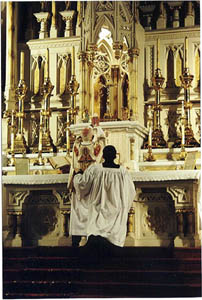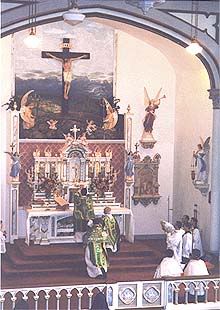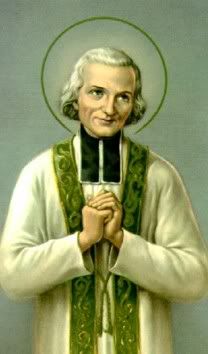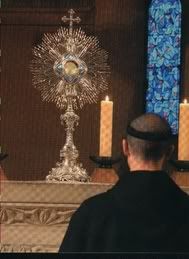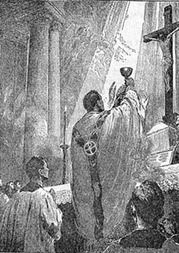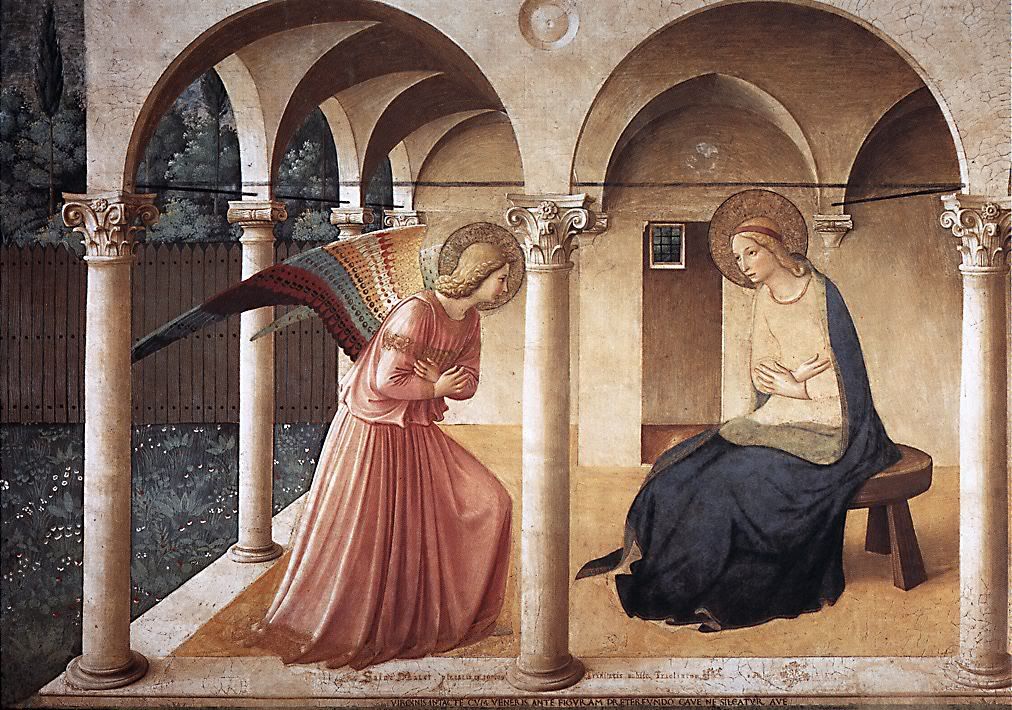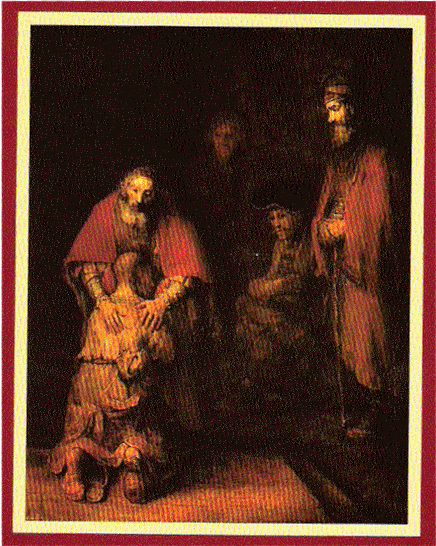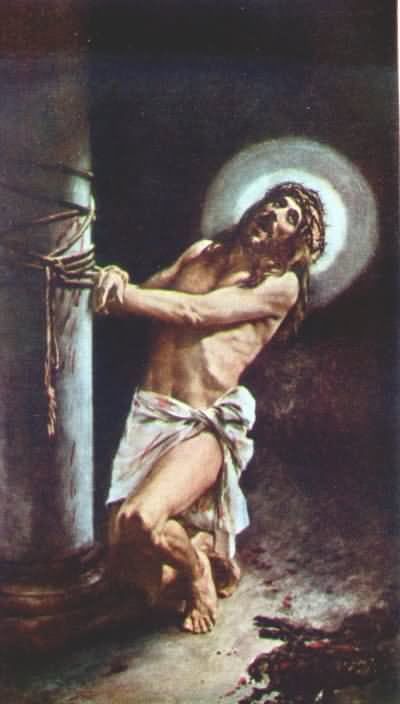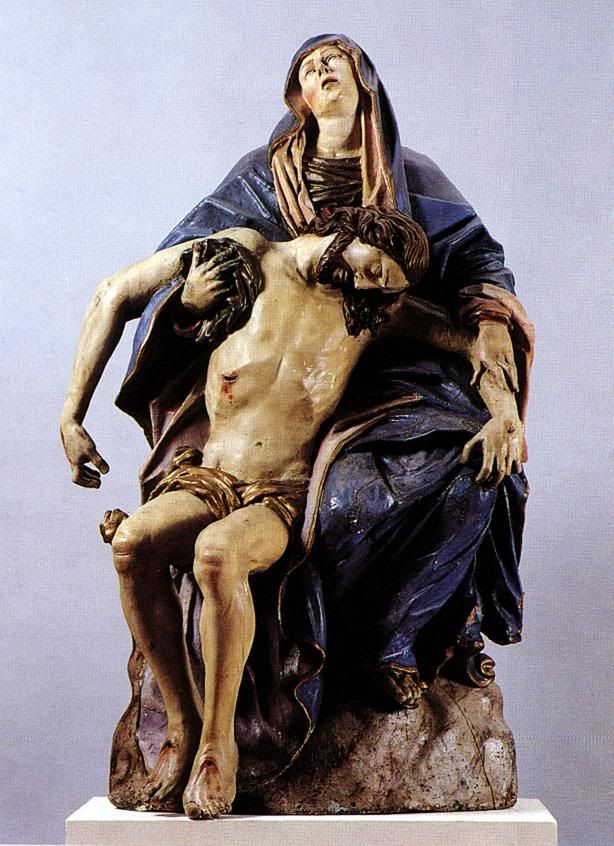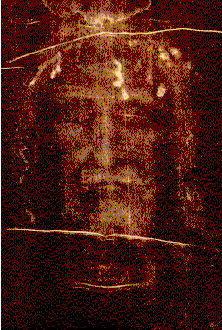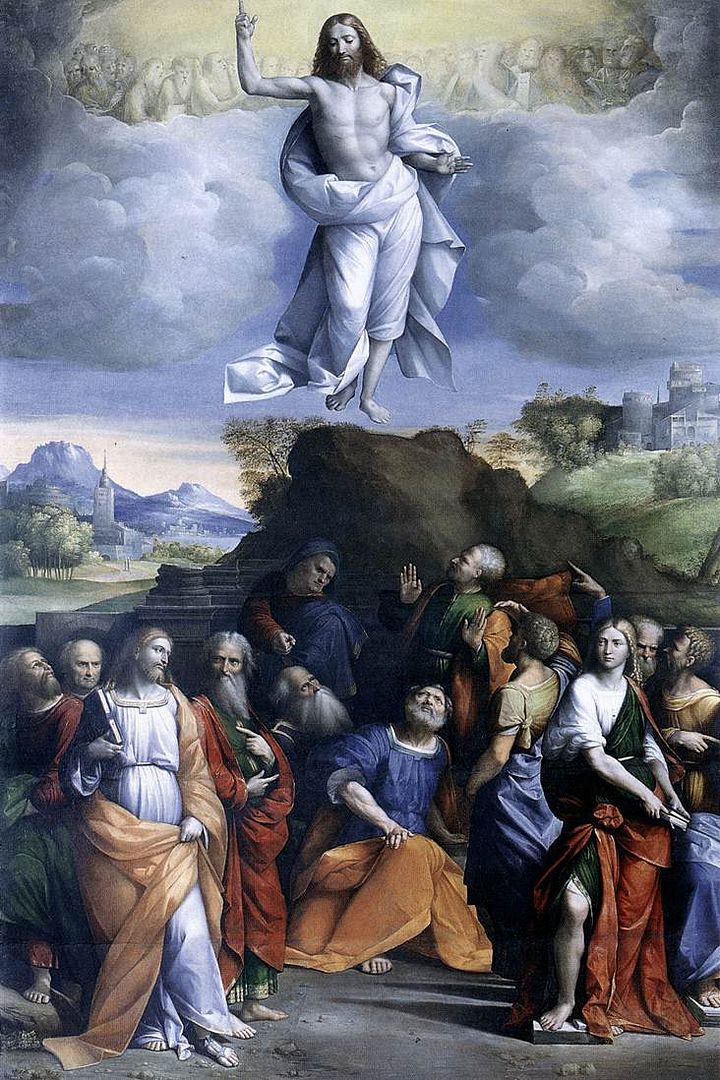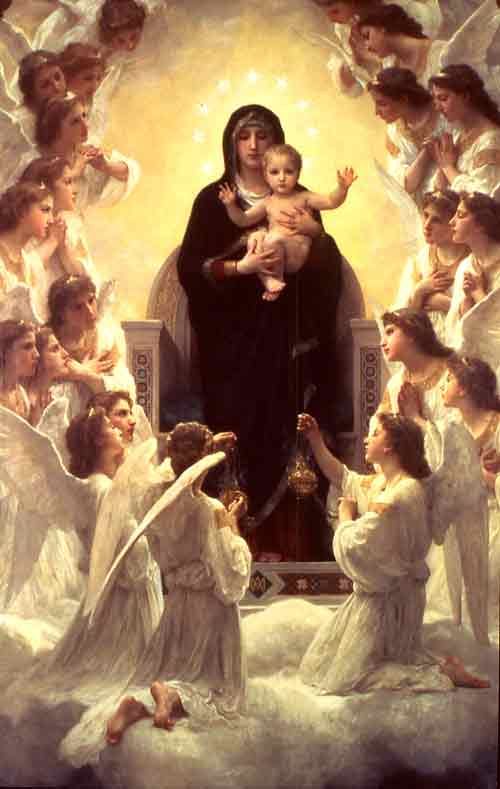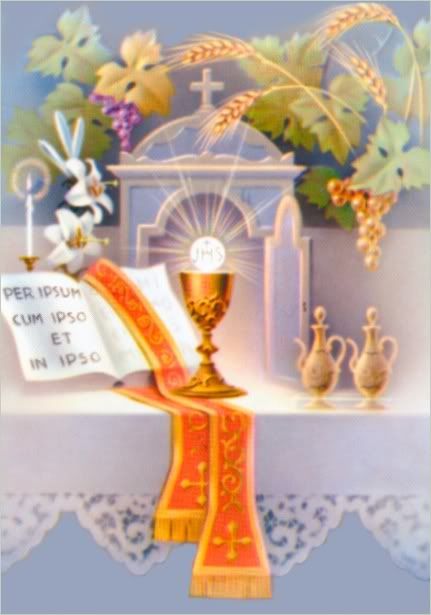Saturday, January 26, 2013
The Deposito Of the Alleluia
The season of Septuagesima begins with Vespers this evening.
We do not now deserve
To sing the Alleluia forever;
Guilt forces us
To dismiss you, O Alleluia.
For the time approaches in which
We must weep for our sins.
From Father Francis X. Weiser, S.J. (former pastor of Holy Trinity, Boston), Handbook of Christian Feasts and Customs:
The depositio (discontinuance) of the Alleluia on the eve of Septuagesima assumed in medieval times a solemn and emotional note of saying farewell to the beloved song. Despite the fact that Pope Alexander II had ordered a very simple and somber way of "deposing" the Alleluia, a variety of farewell customs prevailed in many countries up to the sixteenth century. They were inspired by the sentiment that Bishop William Duranti (1296) voiced in his commentaries on the Divine Office: "We part from the Alleluia as from a beloved friend, whom we embrace many times and kiss on the mouth, head and hand, before we leave him."
The liturgical office on the eve of Septuagesima was performed in many churches with special solemnity, and alleluias were freely inserted in the sacred text, even to the number of twenty-eight final alleluias in the church of Auxerre in France. This custom also inspired some tender poems that were sung or recited during Vespers in honor of the sacred word. The best known of these hymns is, Alleluia, dulce carmen ("Alleluia, Song of Gladness"), composed by an unknown author of the tenth century. It was translated into English by John Mason Neale (1866) and may be found in the official hymnal of the Protestant Episcopal Church.
In some French churches the custom developed in ancient times of allowing the congregation to take part in the celebration of a quasi-liturgical farewell ceremony. The clergy abstained from any role in this popular service. Choirboys officiated in their stead at what was called "Burial of the Alleluia" performed the Saturday afternoon before Septuagesima Sunday. We find a description of it in the fifteenth-century statute book of the church of Toul:
"On Saturday before Septuagesima Sunday all choir boys gather in the sacristy during the prayer of the None, to prepare for the burial of the Alleluia. After the last Benedicamus [i.e., at the end of the service] they march in procession, with crosses, tapers, holy water and censers; and they carry a coffin, as in a funeral. Thus they proceed through the aisle, moaning and mourning, until they reach the cloister. There they bury the coffin; they sprinkle it with holy water and incense it; whereupon they return to the sacristy by the same way."
In Paris, a straw figure bearing in golden letters the inscription "Alleluia" was carried out of the choir at the end of the service and burned in the church yard.
With the exception of these quaint aberrations, however, the farewell to alleluia in most countries was an appropriate addition to the official ceremonies of the liturgy. The special texts (hymns, responsories, antiphons) used on that occasion were taken mostly from Holy Scripture, and are filled with pious sentiments of devotion....
Thus the Alleluia is sung for the last time and not heard again until it suddenly bursts into glory during the Mass of the Easter Vigil when the celebrant intones this sacred word after the Epistle, repeating it three times, as a jubilant herald of the Resurrection of Christ.
1. Alleluia dulce carmen,
Vox perennis gaudii,
Alleluia laus suavis
Est choris coelestibus,
Quam canunt Dei manentes
In domo per saecula.
2. Alleluia laeta mater
Concivis Jerusalem:
Alleluia vox tuorum
Civium gaudentium:
Exsules nos flere cogunt
Babylonis flumina.
3. Alleluia non meremur
In perenne psallere;
Alleluia vo reatus
Cogit intermittere;
Tempus instat quo peracta
Lugeamus crimina.
4. Unde laudando precamur
Te beata Trinitas,
Ut tuum nobis videre
Pascha des in aethere,
Quo tibi laeti canamus
Alleluia perpetim.
We do not now deserve
To sing the Alleluia forever;
Guilt forces us
To dismiss you, O Alleluia.
For the time approaches in which
We must weep for our sins.
From Father Francis X. Weiser, S.J. (former pastor of Holy Trinity, Boston), Handbook of Christian Feasts and Customs:
The depositio (discontinuance) of the Alleluia on the eve of Septuagesima assumed in medieval times a solemn and emotional note of saying farewell to the beloved song. Despite the fact that Pope Alexander II had ordered a very simple and somber way of "deposing" the Alleluia, a variety of farewell customs prevailed in many countries up to the sixteenth century. They were inspired by the sentiment that Bishop William Duranti (1296) voiced in his commentaries on the Divine Office: "We part from the Alleluia as from a beloved friend, whom we embrace many times and kiss on the mouth, head and hand, before we leave him."
The liturgical office on the eve of Septuagesima was performed in many churches with special solemnity, and alleluias were freely inserted in the sacred text, even to the number of twenty-eight final alleluias in the church of Auxerre in France. This custom also inspired some tender poems that were sung or recited during Vespers in honor of the sacred word. The best known of these hymns is, Alleluia, dulce carmen ("Alleluia, Song of Gladness"), composed by an unknown author of the tenth century. It was translated into English by John Mason Neale (1866) and may be found in the official hymnal of the Protestant Episcopal Church.
In some French churches the custom developed in ancient times of allowing the congregation to take part in the celebration of a quasi-liturgical farewell ceremony. The clergy abstained from any role in this popular service. Choirboys officiated in their stead at what was called "Burial of the Alleluia" performed the Saturday afternoon before Septuagesima Sunday. We find a description of it in the fifteenth-century statute book of the church of Toul:
"On Saturday before Septuagesima Sunday all choir boys gather in the sacristy during the prayer of the None, to prepare for the burial of the Alleluia. After the last Benedicamus [i.e., at the end of the service] they march in procession, with crosses, tapers, holy water and censers; and they carry a coffin, as in a funeral. Thus they proceed through the aisle, moaning and mourning, until they reach the cloister. There they bury the coffin; they sprinkle it with holy water and incense it; whereupon they return to the sacristy by the same way."
In Paris, a straw figure bearing in golden letters the inscription "Alleluia" was carried out of the choir at the end of the service and burned in the church yard.
With the exception of these quaint aberrations, however, the farewell to alleluia in most countries was an appropriate addition to the official ceremonies of the liturgy. The special texts (hymns, responsories, antiphons) used on that occasion were taken mostly from Holy Scripture, and are filled with pious sentiments of devotion....
Thus the Alleluia is sung for the last time and not heard again until it suddenly bursts into glory during the Mass of the Easter Vigil when the celebrant intones this sacred word after the Epistle, repeating it three times, as a jubilant herald of the Resurrection of Christ.
1. Alleluia dulce carmen,
Vox perennis gaudii,
Alleluia laus suavis
Est choris coelestibus,
Quam canunt Dei manentes
In domo per saecula.
2. Alleluia laeta mater
Concivis Jerusalem:
Alleluia vox tuorum
Civium gaudentium:
Exsules nos flere cogunt
Babylonis flumina.
3. Alleluia non meremur
In perenne psallere;
Alleluia vo reatus
Cogit intermittere;
Tempus instat quo peracta
Lugeamus crimina.
4. Unde laudando precamur
Te beata Trinitas,
Ut tuum nobis videre
Pascha des in aethere,
Quo tibi laeti canamus
Alleluia perpetim.
Friday, January 25, 2013
The Conversion Of Saint Paul

Gosh! It has been a month since Christmas.
And Septuagesima is this coming Sunday, and the Alleluia is deposited the night before.
Saint Paul, please pray for us!
Saint Peter, please pray for us!
Thursday, January 24, 2013
Saint Timothy, Bishop and Martyr
The Golden Legend on this disciple of Saint Paul, bishop, and martyr.
Saint Timothy, please pray for us!
Wednesday, January 23, 2013
Saint Raymond of Penyafort
Tuesday, January 22, 2013
God Bless Justice Scalia
I have always loved Justice Scalia. At yesterday's Second Inauguration of the person elected President, he was wearing a replica of the hat worn by Saint Thomas More in his portrait by Holbein. Just as the Holy Father sends messages and sets the tone by periodically bringing back items of Papalware that have not been seen for quite a while, Justice Scalia is sending a message in wearing a hat associated with the great defender of the Faith against the secular encroachment of the "Defender Of the Faith."
Monday, January 21, 2013
Saint Agnes, Virgin, Martyr
Sunday, January 20, 2013
Good Golly, Miss Molly!
Can Septuagesima Sunday really be next week? Already???
Yep.
Deposito of the Alleluia next Saturday evening, and back to purple next Sunday. Time to, gulp, start thinking about Lent.
Yep.
Deposito of the Alleluia next Saturday evening, and back to purple next Sunday. Time to, gulp, start thinking about Lent.










